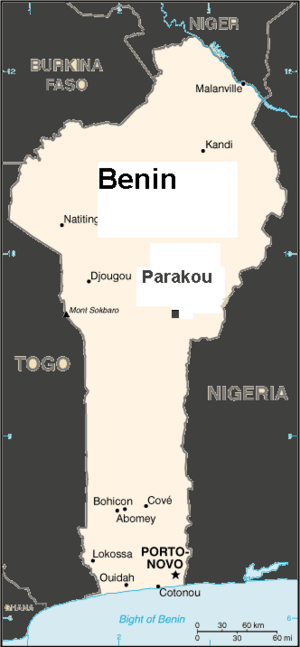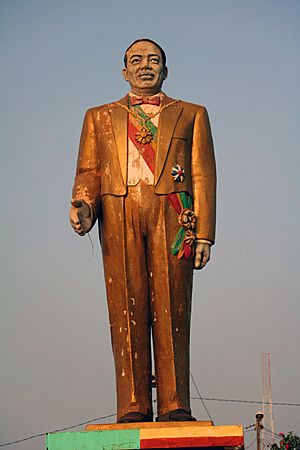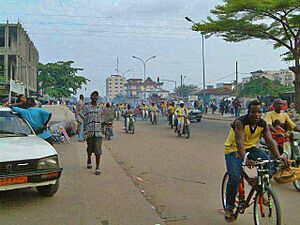Hubert Maga facts for kids
Quick facts for kids
Coutoucou Hubert Maga
|
|
|---|---|

President Hubert Maga, 1961
|
|
| Deputy to the French National Assembly | |
| In office June 17, 1951 – May 22, 1959 |
|
| Premier of Dahomey | |
| In office May 22, 1959 – August 1, 1960 |
|
| Preceded by | Sourou-Migan Apithy |
| Succeeded by | None (office abolished) |
| President of Dahomey | |
| In office August 1, 1960 – October 22, 1963 |
|
| Vice President | Sourou-Migan Apithy |
| Preceded by | None (office established) |
| Succeeded by | Christophe Soglo |
| Chairman of the Presidential Council | |
| In office May 7, 1970 – May 7, 1972 |
|
| Vice President | Justin Ahomadégbé-Tomêtin |
| Preceded by | Paul-Émile de Souza (Chairman of the Military Directorate) |
| Succeeded by | Justin Ahomadegbé-Tomêtin |
| Personal details | |
| Born | August 10, 1916 Parakou, Dahomey |
| Died | May 8, 2000 (aged 83) Cotonou, Benin |
| Political party | Dahomey Democratic Rally |
| Spouse | Marie Do Régo |
| Signature | |
Coutoucou Hubert Maga (born August 10, 1916 – died May 8, 2000) was an important political leader from Dahomey, which is now called Benin. He became famous in a time when politics in Dahomey were often divided by different regions.
Born into a farming family in 1916, Maga worked as a school teacher from 1936 to 1945. During this time, he became very influential among people who had not gone to school. In 1947, he was elected to Dahomey's local assembly. He also started a political group called the Northern Ethnical Group, which later became the Dahomey Democratic Rally.
In 1951, Maga was elected to the French National Assembly in France. He held several important roles, including being the prime minister of Dahomey from 1959 to 1960. When Dahomey became independent from France on August 1, 1960, Maga was chosen as its first president. He was officially elected to this position on December 11.
During Maga's time as president, Dahomey's economy faced difficulties. There wasn't much money invested from other countries, and many people lost their jobs. To help, he started a four-year plan in 1962. This plan aimed to grow more food by encouraging young people to work on farms.
Maga also faced challenges in uniting the country. In 1961, a main opposition leader, Justin Ahomadegbé-Tomêtin, was jailed. By 1962, Dahomey had become a one-party state, meaning only one political party was allowed. In 1963, a convicted person was released from prison, which caused protests across the country. These protests soon turned into bigger demonstrations against Maga's leadership. The situation became so serious that the head of the Dahomeyan Army, Christophe Soglo, took control in October to prevent a civil war. Soglo asked Maga to step down. Maga, Ahomadégbé-Tomêtin, and Sourou Migan Apithy were then given roles as Ministers of State.
Later, Maga was accused of wrongdoing and was held. After his release in 1965, he went to Togo and then to Paris. In 1970, he returned to Dahomey to lead a special three-person Presidential Council. This council included Ahomadegbé-Tomêtin and Apithy, and the leadership rotated. On October 26, 1972, Mathieu Kérékou took power in a military takeover. Maga and the other council members were held until 1981. After his release, Maga retired from public life. He made one public appearance at a big meeting in 1990, which offered forgiveness to all Beninese political exiles. He passed away on May 8, 2000.
Contents
Early Life and Education
Hubert Maga was born on August 10 or 19, 1916, in Parakou, a town in northern Dahomey. His family were farmers. Maga said he was a descendant of the royal family of the Kingdom of Bourgou. His mother was from the Bariba people and his father was from the Mossi people. They raised him in the Islamic faith.
Maga started school in Parakou. His teacher there was the father of Émile Derlin Zinsou, who would also become a future political leader. Maga then went to schools in Bohicon and Abomey. He later moved to Porto-Novo to study at the Victor Ballot School for three years. While studying at the Ponty Normal School in Dakar, Maga became friends with Hamani Diori, who would later become the president of Niger.
In his twenties, Maga changed his religion and became a Roman Catholic. This was not very common for someone from the northern part of the country at that time. In 1935, he became a teacher in Natitingou. In 1939, he married a nurse who was also a Christian. Her father was an important person of Fon origin from Ouidah. Marriages between people from northern and southern Dahomey were unusual back then.
In 1945, Maga became the director of his school. He and his wife started to gain influence among people who had not received much education. After World War II, he worked with trade unions. He led the Teachers' Union of Dahomey (Syndicat des instituteurs du Dahomey).
Political Beginnings
Maga's journey to power happened during a time when different regions of Dahomey had strong feelings against each other. This was due to old disagreements between people from the former kingdoms of Abomey, Porto-Novo, and the northern tribes. This led to three main political areas: the north, the southeast, and the southwest. These areas were led by Maga, Sourou Migan Apithy, and Justin Ahomadégbé-Tomêtin, respectively.
Maga's group, the Ethnic Group of the North, later joined the Dahomeyan Democratic Rally in 1957. This group mostly had support from his northern home region, especially from the Bariba people. Apithy was mainly supported by the Yoruba people, and Ahomadégbé-Tomêtin by the Fon people and Gouns. These regional differences became even stronger throughout the political lives of these three men, who were often called Dahomey's "triumvirate" (a group of three powerful leaders).
Early Political Career
In 1945, Maga was elected as a general adviser for the Atakora Department region. Two years later, he was appointed to the Grand Council of French West Africa, where he served until 1952. After being elected to the Dahomey General Council in 1947, Maga left his teaching job. He then became the vice president of the assembly until 1957.
In 1949, a French official named Roger Peperty encouraged Maga to create a political alliance among people from the north. This party became known as the Northern Ethnic Group. Maga, however, later said that he and his friends came up with the idea themselves.
In the elections of June 17, 1951, Dahomey was allowed to have an extra representative in the French National Assembly. Maga decided to run for this position with Paul Darboux, a rich merchant from the north. He gained support by focusing on the idea that southern Dahomey had too much control over the colony's politics.
The election rules changed in May 1951, allowing more people to vote. However, only 44% of the population actually voted. Maga won the second seat with 49,329 votes. Most of Maga's votes (98%) came from northern towns and villages. This 1951 election is seen as the start of political parties based on regions and ethnic groups in Dahomey.
Serving in the French National Assembly
In Paris, Hubert Maga joined a political group called the Overseas Independents, led by Léopold Sédar Senghor from Senegal. Maga was named the secretary of the Finance Committee and a member of other important committees. During his first term, he proposed a bill about elections in France's overseas territories.
With his party's support, Maga ran for re-election in January 1956. He won 60,601 votes. Later that year, he left his position on the Grand Council of French West Africa. He then became a member of the national education and justice committees. On January 25, 1956, he was named Secretary of the Assembly. In November 1957, when Félix Gaillard became Prime Minister of France, he appointed Maga as the Secretary of State of Labor. Maga held this job until April 1958.
Before the 1959 local elections, Maga agreed that his party, the R.D.D., would only run candidates in the north. In return, Apithy's Republican Party of Dahomey (P.R.D.) would only run in the south. However, Justin Ahomadégbé-Tomêtin's party, the Dahomey Democratic Union (U.D.D.), also won many votes. This caused immediate problems and protests. French soldiers had to be called in to restore order.
After some discussions, Maga was chosen as a compromise candidate for the position of Prime Minister. He was voted into this role on May 22, 1959.
Prime Minister of Dahomey
Maga became Prime Minister at a difficult time for Dahomey's economy. There was not much foreign investment, and unemployment was increasing. Maga felt it was important to talk with trade unions before choosing a Minister of Labor. He eventually appointed Paul Darboux to this role. Although Apithy wanted to be Prime Minister again, he was instead made a Minister of State without a specific department.
In his first speech as Prime Minister, Maga asked the people of Dahomey to stop the regional divisions that had marked the country's politics. He called for unity among supporters of Apithy and Ahomadégbé-Tomêtin and encouraged investments to help the economy.
In September 1959, Apithy threatened to remove his party's members from the government if Maga did not hold a vote on Dahomey's political future. Maga responded by removing Apithy from his cabinet on September 18. He warned other party members that they would face the same if they opposed him.
A vote on Dahomey's independence was held on September 28. Dahomeyans could choose to become a French department, a semi-independent state within the French community, or fully independent. The people chose to become a semi-independent state, with full independence planned for 1960.
Maga gained more public support than Apithy. Maga started to form an alliance with Ahomadegbé-Tomêtin, especially after Apithy supported joining the short-lived Mali Federation, which Maga opposed. In January 1960, Maga added more members from Ahomadegbé-Tomêtin's party to his government.
On August 1, 1960, Maga went to Paris to discuss Dahomey's future. After talks, Dahomey was granted its independence. When Maga returned home on June 13, he said he had personally asked for independence. Maga was then chosen to be Dahomey's first president.
President of Dahomey
Early Presidency and Challenges
Soon after Dahomey gained independence, the three main political parties joined together. They aimed to unite Dahomey into one voting area. However, this unity did not last long. Ahomadégbé-Tomêtin left the union and encouraged protests. These protests were fueled by people's unhappiness about job shortages in the country.
Dahomey faced a major economic downturn. The country had not had a good trade balance since 1924, and now that it was independent, France no longer provided financial support. Maga tried to help by investing in roads and buildings and encouraging government workers to live in Dahomey. Still, Dahomey's economy grew very slowly, making it one of the weakest in Africa.
Maga also worked to get his party, the R.D.D., recognized as part of the larger African Democratic Rally. This helped bring a new political focus to the R.D.D., which had mostly been about regional interests before.
In October, Ahomadégbé-Tomêtin convinced the trade unions he controlled to start another strike. They were protesting Maga's handling of the economy and the welfare of workers. The strike lasted two days in Porto-Novo and Cotonou and became serious, with police using tear gas. It ended when Maga sent loyal supporters from the north to patrol the streets. On November 2, members of Ahomadégbé-Tomêtin's party tried to remove Maga from power through a vote in the National Assembly. Maga got help from Apithy, and the attempt failed.
New Constitution and Official Election
After the attempt to remove him failed, members of Ahomadégbé-Tomêtin's party started to resign from their jobs. On November 13, Maga's party and Apithy's party officially merged to form the Dahomeyan Unity Party (P.D.U.), and Maga was chosen as its leader. He then created a new constitution for Dahomey, similar to France's. The assembly approved this constitution on November 25. The new constitution gave the president more power, including the ability to ask the National Assembly to rethink bills and to hold public votes (referendums). Maga also became the Commander in Chief of the Dahomeyan Army.
A new election law meant that every party had to list candidates for all 60 National Assembly seats, as well as for president and vice president. Maga's only opponent for president was Ahomadegbé-Tomêtin. On December 11, 1960, Maga was officially elected president for a five-year term. He received 468,002 votes, and Apithy became vice president for the same term. The P.D.U. won 69% of the votes and all 60 seats in the National Assembly.
Maga's first cabinet resigned on December 29. The next day, he named new ministers, choosing many leaders from his former party. To avoid problems with the opposition, Maga and his ministers moved their offices from Porto Novo to Cotonou, where Ahomadégbé-Tomêtin's party had received many votes.
Dealing with Opposition and Economic Plan
In early 1961, President Maga began to restrict opposition newspapers and anyone he thought might cause trouble. This effectively silenced Ahomadégbé-Tomêtin's influence. His party's newspaper was shut down in February. Maga also created a group to share government news with people who were not educated. Maga's own General Union of Dahomeyan Workers replaced Ahomadégbé-Tomêtin's trade unions.
By April, most members of Ahomadégbé-Tomêtin's party wanted to join Maga's party, which Maga encouraged. Ahomadégbé-Tomêtin was not happy about this. Maga dissolved Ahomadégbé-Tomêtin's party on April 11, and his trade unions less than a week later. Maga declared that Dahomey had "at last been born." Since Ahomadégbé-Tomêtin could not launch a military takeover, he decided to plan against the president.
On May 26, Maga was told that Ahomadégbé-Tomêtin had planned to harm him. Ahomadégbé-Tomêtin and 11 others were arrested and put on trial in December. The trial was public, and the accused had a lawyer from Paris. Ahomadégbé-Tomêtin was sentenced to five years in jail. Maga released them all on November 3, 1962, saying it was for their good behavior and to make peace with his former rivals.
With the opposition under control, Maga could focus on the economy. He created a four-year growth plan, starting January 1, 1962. This plan aimed to increase farm production and was funded by France. Part of the plan involved cutting wages by ten percent. Young Dahomeyans were expected to contribute to "human investment," which meant community work projects on the land. If they refused, Maga could take away their citizenship.
To prevent student protests, the president combined Dahomey's two main youth organizations into the National Union of Dahomeyan Youth. This organization was to be run nationally and not connected to any international groups. Maga would only warn students who protested, not even taking away their scholarships. On December 31, 1961, Maga's government raised certain taxes to balance the country's budget. Maga traveled around Dahomey to promote his plan, offering undeveloped land to supporters.
Despite economic difficulties, the president ordered a new presidential palace to be built. It cost US$3 million and was completed in 1963. The palace was a grand building in Cotonou.
In February 1962, Maga changed his cabinet. He added planning and development duties to Apithy's office to satisfy his desire for power. However, Apithy accused Maga of being a dictator. A series of protests organized by the Vice President eventually led to Maga leaving office. These protests were sparked by the death of a local official named David Dessou.
Protests and the 1963 Military Takeover
In January 1962, David Dessou, an official, was poisoned. A local deputy named Christophe Bokhiri was accused and arrested. He was released after other deputies in the National Assembly asked for the case against him to be stopped, using a rule that protects members of parliament. Maga was in Paris during this time.
The people of Dahomey were very angry about Bokhiri's release. In the summer of 1963, conflicts broke out between different ethnic groups, as the accused and the victim were from different tribes. Protests started in Porto-Novo on October 21 and quickly spread to Cotonou. The protests became more serious when trade unionists joined in. They were still upset about the wage cuts and used the case to push for their own goals. They also criticized Maga for spending too much money, like on the presidential palace. Most protests were peaceful, but some people damaged a hospital sign with Maga's name on it. Six trade unionists were arrested, leading the unions to call a general strike. By the end of the second day, protesters forced the National Assembly to put Bokhiri back in jail. The Assembly also put a curfew in place.
Because of these events, Maga canceled his trip to the United States and returned to Dahomey immediately. He asked for peace and called a special meeting of the National Assembly. However, the protesters and trade unionists did not accept his attempts to make peace. When Maga agreed to their demands and formed a temporary government where Apithy and Ahomadégbé-Tomêtin had equal power, they protested this new arrangement too. Armed supporters of Maga from the north came to Cotonou and clashed with the protesters, killing two people. The protesters refused to return to their jobs until Maga was no longer president.
Their wish came true. On October 28, the head of the Dahomeyan Army, Christophe Soglo, took control of the country to prevent a civil war. He dismissed the government, dissolved the Assembly, suspended the constitution, and banned all protests. After Maga signed his resignation that same day, Soglo gave Maga, Apithy, and Ahomadégbé-Tomêtin roles as Ministers of State. Southern Dahomey later built a statue to remember this day in their history.
Minister of State and Later Life
The temporary government dissolved Maga's party and created a new one. It announced that a vote on the constitution would be held on December 15. A committee was also set up to investigate accusations against Maga's government. In late November, they began to prosecute former cabinet members for misusing public money.
Despite their friendly relationship, Soglo held Maga responsible for a plan to harm him that was discovered in early December. Maga resigned from his position in the temporary government on December 4. He was then placed under house arrest in a village, accompanied by a butler, cook, and driver. Four other former cabinet members were held in less comfortable prisons. During an official inquiry, the conspiracy charge was dropped, but Maga was found responsible for corruption.
In May 1964, some of Maga's loyal supporters tried to free him from house arrest and bring him back to power. Their actions became so intense that the military had to step in to stop the uprisings. In March 1965, after a new trial, Maga was released from house arrest. He went to live in Togo before moving to Paris.
During Maga's time in exile, there were many attempts to overthrow Presidents Soglo, Apithy, and Ahomadégbé-Tomêtin. Maga formed a new party, the Union Nationale Dahoméenne (U.N.D.), in December 1965, hoping to be recognized in upcoming elections. Maga and Apithy protested a special meeting of the National Assembly in December 1965 that would vote on a new constitution. This meeting was never held. On December 22, Soglo took power again and refused to hold elections.
More military takeovers followed. Eventually, the military decided to return the country to civilian rule. All former presidents, vice presidents, and government ministers were not allowed to run in Dahomey's first election since 1964, held on May 15, 1968. Maga and Apithy protested this, while Ahomadégbé-Tomêtin supported another candidate. The candidate won, but the election results were canceled because the protests prevented many people from voting. This led to more protests, and Maga, Soglo, Apithy, and Ahomadégbé-Tomêtin were forbidden from entering the country to stop the unrest.
After more military takeovers, Émile Derlin Zinsou was appointed civilian President of Dahomey by the military on June 17, 1968. Maga, Apithy, and Ahomadégbé-Tomêtin united in Paris to oppose this appointment. They formed the National Front for the Struggle of Dahomey. They tried to boycott Zinsou's appointment and the public vote he chose to hold. However, their plan was not successful, and Zinsou was confirmed as President of Dahomey on July 28.
The 1970 Election and Presidential Council
On December 10, 1969, Zinsou was overthrown by Maurice Kouandété. The military did not agree on who should lead, so a Military Directorate was set up with Paul Emile de Souza as its chairman. An election was held on March 28, 1970, to choose the next president. This time, Maga, Apithy, and Ahomadégbé-Tomêtin were allowed to campaign. The election was marked by strong regional loyalties and some violent incidents.
Maga received most of the votes in the north, while Apithy and Ahomadégbé-Tomêtin received most votes in the southeast and southwest/central, respectively. Maga received 252,551 votes. However, de Souza decided to cancel the results from the Atakora Department, where Maga had received the most votes.
Maga was very angry about this. He formed a group called the Assembly of the Peoples of the North, which threatened to separate from Dahomey unless he was declared President. He refused to leave his campaign office. Maga's reaction caused many workers from the south to leave the north. Apithy said he would convince his region to join Nigeria if Maga became president. Ahomadégbé-Tomêtin claimed Maga had cheated in the election. To prevent a civil war, the former presidents agreed to a quick compromise on April 13.
Leading the Presidential Council
A Presidential Council was formed on May 7, made up of Maga, Ahomadégbé-Tomêtin, and Apithy. The presidency of the council would change every two years. Maga was the first chairman for the first two years. Each leader agreed not to use the military to stay in power. If decisions were not agreed upon by everyone at first, a majority of two council members would be enough in a second vote. This council acted as both the executive and legislative branches of Dahomey.
The cabinet (the group of ministers) was made up of four allies of Ahomadégbé-Tomêtin, three allies of Maga, and three allies of Apithy. Important positions like finance, information, education, and communication were filled by these allies. Daouda Badarou, who had been the foreign minister before, kept his job.
Maga's economic policies during his time as chairman helped calm union leaders who had protested during his presidency. He helped create a tax plan to pay salaries by cutting expenses and stopping tax evasion. In 1970, Dahomey had a financial surplus of 429 million CFA francs, which grew to 570 million CFA francs the next year. With the economy doing well, Maga and the council could afford some luxuries, like three houses and three Mercedes-Benz 300 cars to share, and celebrations for the council's anniversary.
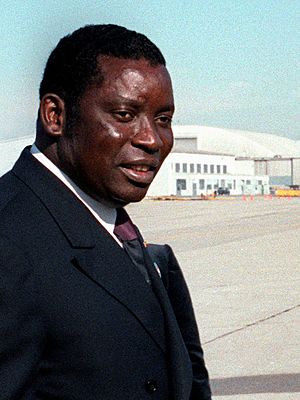
The Council became less popular because of the Kutuklui Affair. On October 27, 1971, Maga and the council decided to expel Noe Kutuklui, a Togolese opposition leader, from Dahomey. This was at the request of General Gnassingbé Eyadéma, the president of Togo, because Kutuklui was involved in plans against Eyadema's government. The Council's decision caused protests in Cotonou. Maga could not carry out his decision because a military officer protected Kutuklui and took him out of Dahomey.
Students were also involved in protests. On November 5, 1971, Maga's government shut down a student group called the Union Général des Etudiants et Eleves de Dahomey (UGEED). This group was seen as radical and aimed to cause trouble. This happened after UGEED organized protests against the minister of education. Students who participated in the strike were allowed back to school on November 19, but only if their parents signed documents promising they would not protest again. If they failed to follow this, they would be expelled from school. The government also organized rallies to support the ban.
The military was also unhappy. The formation of the presidential council made the army even angrier. On May 7, 1971, Ahomadégbé-Tomêtin was attacked while traveling. Maga first denied it happened, and details are still unclear. Another military uprising happened on January 28, 1972, at an artillery camp. The president sent officers to stop the rebels, but no one was punished. Both Ahomadégbé-Tomêtin and Maga believed this was an attempted military takeover.
Kouandété tried to take power again on February 23. Ahomadégbé-Tomêtin initially thought it was Maga trying to stay in power. Kouandété tried to take over government buildings and harm de Souza. The plot failed. Maga canceled a trip to France to deal with the situation. A military commission later found another plot that was supposed to happen at the same time as Kouandété's. These events showed the Council's "fear and contempt" for the military.
Under Ahomadégbé-Tomêtin and Final Overthrow
Maga handed over power to Ahomadégbé-Tomêtin on May 7, 1972. This was the first time in 12 years that the leader of Dahomey was replaced without military force. The new chairman congratulated Maga and praised the triumvirate as "one of [Dahomey's] most beneficial institutions." Many believed the smooth transfer of power was a positive step for Dahomeyan unity.
The Presidential Council was slow to organize a military trial, which finally began on May 12. The court tried 21 men, mostly military officers, for their roles in the attempted takeover. The punishments were announced on May 16. Kouandété and some others received the death penalty, while others received long prison sentences. However, these sentences were never carried out.
Another delayed task of the Council was forming the National Consultative Assembly, an advisory group required by the 1970 constitution. This assembly was meant to have 30 members advising the council on various issues. It was not established until July 1972, due to disagreements among the council members and pressure from their political supporters.
One notable event during Ahomadégbé-Tomêtin's time in power was the Kovacs Affair. It started with accusations of bribery and misuse of money involving a minister. Ahomadégbé-Tomêtin tried to fire the minister, but Maga, who was the minister's mentor, refused. Maga convinced Apithy to help, and the decision was blocked.
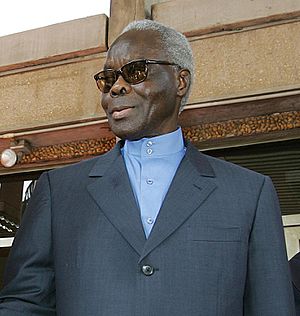
Another military takeover was launched on October 26 by soldiers. This one was successful, and Major Mathieu Kérékou became president. It happened during a cabinet meeting with Maga and Ahomadégbé-Tomêtin. Kérékou had been Maga's assistant in 1961. Soldiers reportedly entered the presidential palace and started firing, but no one was hurt. Kérékou called the triumvirate a "monster" and accused it of "unpardonable incompetence" to justify the takeover. Kouandété was pardoned, but the former council members were not. Maga, Ahomadégbé-Tomêtin, and Apithy spent more than nine years in prison before Kérékou released them in 1981.
Later Life and Legacy
In 1989, Maga established the National Party for Democracy and Development. He participated in the National Conference of 1990, which granted forgiveness to all Beninese political exiles. He also served as a member of the High Council of the Republic before retiring from political life. He made some public appearances, such as at independence day celebrations in 1998. At the time of his death, he was a member of Dahomey's Constitutional Court. Hubert Maga passed away from a heart attack in Cotonou on May 8, 2000. A hospital in Cotonou is now named after him.
Honours
 Vatican City : Collar of the Order of Pope Pius IX (September 14, 1962).
Vatican City : Collar of the Order of Pope Pius IX (September 14, 1962). Empire of Iran : Commemorative Medal of the 2500th Anniversary of the founding of the Persian Empire (October 14, 1971).
Empire of Iran : Commemorative Medal of the 2500th Anniversary of the founding of the Persian Empire (October 14, 1971).
Images for kids
See also
 In Spanish: Hubert Maga para niños
In Spanish: Hubert Maga para niños


